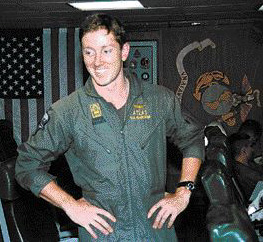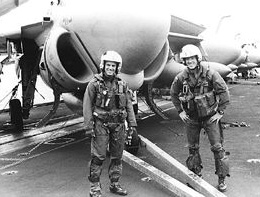Witnesses watch flight's plunge
Both of the men in the A-6E Intruder were respected, experienced aviators

|
The story so far: Nicknamed "Atlas" after the map publisher, Lt. Cmdr. Randall E. McNally II was an extraordinary man from an extraordinary Irish-Catholic family of 10 children. His brother Edward wrote speeches for President Bush. A sister has appeared in TV shows such as Ally McBeal and Seinfeld. Rand joined the Marines and became an A-6 pilot, living a storybook life until April 5, 1994. |
 MCNALLY FAMILY PHOTO
'RAND SPENT . . . HIS LIFE brilliantly piloting America's jeeps, America's Corvettes and America's jet airplanes,' his brother Edward once wrote.
MCNALLY FAMILY PHOTO
'RAND SPENT . . . HIS LIFE brilliantly piloting America's jeeps, America's Corvettes and America's jet airplanes,' his brother Edward once wrote. |
By Russell Carollo
Both were experienced aviators, respected by their peers. Both were well-rested, in good health. Tests would later show neither was under the influence of drugs or alcohol.
Dayton Daily News
By April 5, 1994, Lt. Cmdr. Randall E. McNally II had accumulated nearly 2,100 hours flying airplanes, 1,289 of those in the A-6E Intruder. The bombardier-navigator, Lt. Cmdr. Brian R. McMahon, also a civilian airline pilot, had even more time flying in A-6Es.
Eight minutes later, at four minutes before noon, Firebird 507 was following the lead aircraft past the San Francisco Oakland Bay Bridge. One minute later, Firebird 507 made a routine radio transmission to air traffic controllers at the Alameda tower, who advised the pilots to follow the lead aircraft.
It was the last transmission Firebird 507 would make.
Petty Officer 1st Class Robert H. Kruger, the Alameda tower supervisor that day, had just put some popcorn in his microwave when he spotted Firebird 507 about a half mile south of runway 31.
He watched Firebird 507 make a normal turn, but then he became concerned when the plane's nose started pointing downward after a 90 degree bank.
"At this time I yelled at the local controller: altitude safety alert.' I observed what appeared to be flame from the left wing when the aircraft was approximately 200 feet above the water," Kruger told accident investigators. "I saw the aircraft hit the water left wing first, followed immediately by the nose."
Donald Gobert, aboard a boat anchored nearby, told investigators he saw "a bright orange flash," and then saw the pilots eject.
Edward F. Eseh also watched from a boat.
"I know I should not assume, but being a licensed pilot, something I believe let go in the primary control system, mainly ailerons -- pure conjecture -- but that pilot started to get back (control). Then I think everything let go," Eseh said in a signed statement to investigators.
 MCNALLY FAMILY PHOTO
LT. CMDR. RANDALL E. MCNALLY II (right) is shown aboard the U.S.S. Ranger aircraft carrier in 1986. A few months later, McNally made a successful landing on the carrier during a dark and foggy night.
MCNALLY FAMILY PHOTO
LT. CMDR. RANDALL E. MCNALLY II (right) is shown aboard the U.S.S. Ranger aircraft carrier in 1986. A few months later, McNally made a successful landing on the carrier during a dark and foggy night. |
Thompson, whose boat was only a quarter mile from the crash site, watched the plane sink quickly as he steered his boat toward the crash site, spotting one of the pilots in the water. Thompson had five, 10-year old boys aboard his fishing boat, along with a woman, Lark Roper.
"I asked Lark to keep the young boys out of the way and not to let them look at the body in the water because I knew it was going to be traumatic," said Thompson, who watched a Coast Guard boat arrive just as he got to the site. "The young Coast Guardsmen were not so sure what to do and looked shocked at the sight of this airman in the water."
No one was sure if the man was still alive.
Official statistics mask actual number of crashes
Even deadly accidents may not be counted
Sidebars to Part 4:
ANATOMY OF A CRASH - PART 4
Witnesses watch flight's plunge
Both of the men in the A-6E Intruder were respected, experienced aviatorsCrash that transfixed nation left no trace in Air Force data
It was ruled a crime, not an accident